Last Updated on January 6, 2024 by Greg Gillson
I’ve put this resource together for you to answer your question: What birds are in my backyard in Georgia?
This article lists and discusses the identification of the most common birds in your backyard. The birds chosen in this article are compiled from actual data from the citizen science program eBird. Thus, it is more accurate than some other similar articles you may find on the web. I provide pictures of each bird species mentioned and I’ll tell how to attract them to your backyard.
These are the most common backyard birds in Georgia:
- Northern Cardinal
- Carolina Wren
- Carolina Chickadee
- Tufted Titmouse
- Mourning Dove
- Red-bellied Woodpecker
- Blue Jay
- American Crow
- Northern Mockingbird
- Eastern Towhee
- Downy Woodpecker
- Eastern Bluebird
- House Finch
- American Robin
- Eastern Phoebe
- American Goldfinch
- Brown-headed Nuthatch
- Chipping Sparrow
- Brown Thrasher
- Pine Warbler
- White-breasted Nuthatch
- Yellow-rumped Warbler
- Song Sparrow
- Red-winged Blackbird
- Ruby-crowned Kinglet
- White-throated Sparrow
- Ruby-throated Hummingbird
Georgia Birds and Birding in Georgia State
eBird lists over 440 types of birds as occurring in the state of Georgia.
The most common bird in Georgia: the most frequently seen bird in the state is Northern Cardinal. It is reported on 64% of bird watching lists.
If you are serious about knowing the birds native to Georgia, then check out eBird for Georgia. It has recent sightings and photos, illustrated checklists with weekly abundance bar charts for state, counties, and individual hotspots of the best birding locations.
If you want to know about other people interested in birds in your area, join a local bird group. The American Birding Association maintains a list of bird watching clubs for each state.
Georgia Bird Identification
This section is the species accounts. These are designed to help you to recognize birds you see in your backyard. I have used eBird to select the birds that are most common. “Common” means the birds seen most often throughout the year, not necessarily the most numerous.
Each species account starts with an image. In the identification section I am using size and shape and bill type before considering the color or patterns on the birds. I find these more reliable when trying to identify an unknown bird. Pay attention to body and tail shape and especially bill shape of birds you see, not just plumage color.
In the section on bird feeders and foods I tell how to attract each species. Not all types of backyard birds will come to feeders. But all backyard birds can be attracted with water. So don’t forget to add a birdbath to your bird feeding station.
North Georgia? South Georgia? Central or Middle Georgia? Do live in the North Georgia Mountains or Coastal Georgia? Northeast Georgia? Northwest Georgia? Southeast Georgia? Southwest Georgia? To appear in this article, most birds are widely distributed throughout the state and are often year-round residents. However, for those birds that are more localized in place or time, I list the general region and seasonality. Please see the section following these species accounts for the lists of common species by season.
Even if a species is found in a general area, they occur only in the habitat they prefer. So, the exact habitat of your neighborhood is important for the presence of absence of certain kinds of birds.
1. Northern Cardinal (Cardinalis cardinalis)
This is one of the most common and popular backyard birds in the eastern half of the United States.
 |
| Northern Cardinal. GeorgeB2 Pixaby |
Range in Georgia: Northern Cardinals are year-round residents throughout Georgia.
Identification:
Size: Cardinals are a bit smaller than American Robins, about the same size as Red-winged Blackbirds.
Shape: Plump body with fairly long full tail. Wispy crest.
Bill: Short, heavy, conical, pink. Color: That bright red color is matched by few other birds. Black face. The female is grayer, but with hints of red in wings and tail, and has a crest, too.
Habitat, range & behavior: Cardinals are year-round residents in shrubby woodland edges.
They are found from the eastern United States to Texas and Arizona south into Mexico.
That large conical bill is made for chewing seeds. Watch them crack open sunflower seeds, spit out the hulls, and pluck the kernel with their tongues!
Food and feeder preference: Attract with black oil sunflower seeds. Many types of seeds, berries, nuts in larger hopper or tray feeders.
You may like my in-depth article on attracting Northern Cardinals.
2. Carolina Wren (Thryothorus ludovicianus)
This is a fairly common backyard bird in the much of the eastern United States.
 |
| Carolina Wren. theSOARnet Pixabay |
Range in Georgia: Carolina Wrens are year-round residents throughout Georgia.
Identification:
Size: A smaller bird, between the size of American Goldfinch and House Finch.
Shape: Round body, short neck, flat head, long tail flipped about actively.
Bill: Fairly long, thin, pointed and slightly curved.
Color: Upper parts rusty brown with black bars on the wings and tail. A white eyebrow line and buff under parts.
Habitat, range & behavior: Shrubby thickets and brushy suburban yards.
It is found in the southeastern United States and Yucatan. Northern parts of range expand and contract depending upon harshness of winters.
Males sing throughout the year and are very loud for their size.
Food and feeder preference: Diet is mostly insects and spiders. They will feed on suet.
3. Carolina Chickadee (Poecile carolinensis)
Chickadees are common feeder birds throughout much of North America. This one is common backyards in the southeastern United States.
 |
| Carolina Chickadee. GeorgeB2 Pixabay |
Range in Georgia: Carolina Chickadees are year-round residents throughout Georgia.
Identification:
Size: This small bid is the size of an American Goldfinch.
Shape: Round body, round head, longer tail.
Bill: Short, straight, stout.
Color: Gray above. Paler below. Black cap, white face, black bib.
Habitat, range & behavior: Lower elevation deciduous forests, wooded residential areas.
This chickadee is a resident in the southeastern US.
Chickadees cannot chew as sparrows do, so they take one large sunflower seed at a time from your feeder and fly off to a branch to pound it open with their stout bills.
Food and feeder preference: Most of their diet is insects, also seeds. Attract with black oil sunflower seeds from hopper feeders.
4. Tufted Titmouse (Baeolophus bicolor)
Related to chickadees, they lack the black bib, but have a crest instead.
 |
| Tufted Titmouse. anne773 Pixabay |
Range in Georgia: Tufted Titmice are year-round residents throughout Georgia.
Identification:
Size: A small bird, but a large titmouse, this species is larger than chickadees, about the size of a junco or House Finch.
Shape: Rounded body, long full tail, big head, long legs.
Bill: Short and stout, compressed (taller than wide), black.
Color: Dark blue-gray above, pale below. Black feathers around eye accentuates its size.
Habitat, range & behavior: Lives in deciduous forests with heavy canopy, parks.
Found in eastern and southeastern United States is expanding its range north and west.
Backyard bird feeders might be helping this species expand its range northward.
Food and feeder preference: Diet is insects and seeds. At your hopper or tray feeder attract with black oil sunflower seeds and suet.
5. Mourning Dove (Zenaida macroura)
Mourning Doves are the most widespread and most frequent backyard bird in the Lower 48 states of the United States.
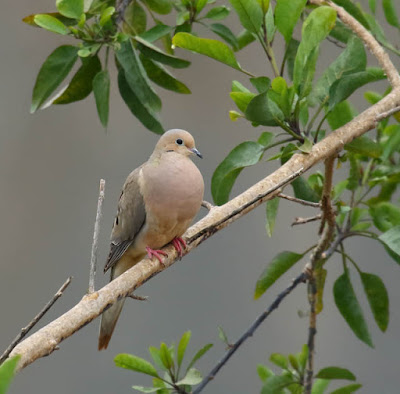 |
| Mourning Dove. Greg Gillson |
Range in Georgia: Mourning Doves are year-round residents throughout Georgia.
Identification: This is a key species for comparing with an unknown bird.
Size: About 12 inches long from bill tip to tail tip. About same size as Northern Flicker. Larger than American Robin. Slightly smaller than domestic city pigeon.
Shape: Very plump with a small round head. Tail is long and pointed. Legs are short.
Bill: Small and rather slender.
Color: Pale brown-pink body, darker wings and tail. White edges on side of tail.
Habitat, range & behavior: Semi-open areas such as urban areas, farmlands, woods.
It is a resident across the lower-48 states and Mexico, with some movement out of northern areas in winter.
Often seen perched on wires, fences. Their mournful cooing is a familiar spring birdsong.
Food and feeder preference: Mourning Doves eat seeds almost exclusively. Attract with black oil sunflower seeds on a large sturdy tray feeder or on the ground.
6. Red-bellied Woodpecker (Melanerpes carolinus)
This is one of the most common species in the eastern half of the United States.
 |
| Red-bellied Woodpecker. skeeze Pixabay |
Range in Georgia: Red-bellied Woodpeckers are year-round residents throughout Georgia.
Identification:
Size: Fairly large for a backyard bird. Between a Starling and American Robin in size. Smaller than a Northern Flicker.
Shape: Stout with large head and short tail. Clings to tree trunk on strong short legs propped up with short stiff tail.
Bill: Long, chisel shaped.
Color: Pale gray body, many thin black-and-white bars across back and wings. Red nape, extending forward on crown on male.
Habitat, range & behavior: These birds are found in many woodland types, including oak, hickory and pine.
They are found from the eastern slope of the Rocky Mountains in the lower-48 states from Texas to extreme southern Canada, and eastward from Florida northward just to the southern edge of the New England states.
In typical woodpecker fashion, they hitch up the tree trunk and larger branches using their tail as a support.
Food and feeder preference: This species eats insects and nuts. They may eat peanuts from a tray feeder and eat from a suet block.
7. Blue Jay (Cyanocitta cristata)
A common and well-known bird in the eastern half of the United States.
 |
| Blue Jay. skeeze Pixabay |
Range in Georgia: Blue Jays are year-round residents throughout Georgia.
Identification:
Size: About that of American Robin.
Shape: Fluffy, large crested head, ample tail. Large strong legs.
Bill: Black, long and stout.
Color: Blue above, white below. Black neck collar. White patches in wing.
Habitat, range & behavior: Woodlands and towns.
They are found in the eastern half of the United States, in summer into southern Canada.
Bold and brash. May bully smaller birds. Jays gulp lots of seeds or other food at once, storing it in their crop. Then they fly off and bury food items in a hidden cache.
Food and feeder preference: Omnivorous. They can quickly empty your feeder! Because they are also aggressive toward other feeder birds, some people put mesh cages around smaller bird feeders. Small birds can go through, squirrels and larger “pest” birds are prevented entry. Some people feed jays peanuts, perhaps away from the seed feeders.
8. American Crow (Corvus brachyrhynchos)
This larger all-black bird is common in cities and country. Its cawing call is familiar to most people.
 |
| American Crow. Greg Gillson |
Range in Georgia: American Crows are year-round residents throughout Georgia.
Identification: This is a key species for comparing with an unknown bird.
Size: About 17-1/2 inches long from bill tip to tail tip, though there is much size variation throughout its range. Larger than blackbirds and grackles. Smaller than ravens.
Shape: Thick neck, large head, rather short square-ended tail. Longer legs. In flight has rounded wing tips with each primary feather separated from others forming “fingers.”
Bill: As long as head, thick, black.
Color: Glossy black throughout.
Habitat, range & behavior: They prefer open areas with trees, fields, farms, cities.
They are common across most of the United States lower-48, except in the desert southwest. They move into southern Canada in summer.
They gather in evening communal roosts in large flocks that may number into the thousands and then move out at dawn into the surrounding area.
Food and feeder preference: Omnivorous, they feed on large insects, grain, small mammals, carrion. You probably don’t want these large entirely black birds in your backyard feeders. So don’t feed table scraps to birds.
9. Northern Mockingbird (Mimus polyglottos)
This bird sings from exposed perches most of the year and often through the night. They have an unending supply of their own unique short phrases that they repeat about 3 times each, but frequently intersperse songs of other birds.
 |
| Northern Mockingbird. Greg Gillson |
Range in Georgia: Northern Mockingbirds are year-round residents throughout Georgia.
Identification:
Size: The length of an American Robin.
Shape: Slender and long tailed. Long legs.
Bill: Medium length, slender, slightly curved.
Color: Gray, darker above, with white patches in wing and tail.
Habitat, range & behavior: They prefer edge habitat with scattered trees and bushes, parks and residential areas.
They are found in eastern and southern parts of the US, West Indies, and south into Mexico. In summer birds are found a bit farther north.
They boldly defend their nests from other birds, cats, and intruders.
Food and feeder preference: Diet is insects, berries, and fruit. You may attract mockingbirds to your feeder with grapes, raisins, apple slices. They will come to a suet block. They readily use a bird bath.
10. Eastern Towhee (Pipilo erythrophthalmus)
This big ground-dwelling sparrow was recently split from Rufous-sided Towhee, creating the Eastern Towhee in the East and the Spotted Towhee in the West.
 |
| Eastern Towhee. skeeze Pixabay |
Range in Georgia: Eastern Towhees are year-round residents throughout Georgia.
Identification:
Size: About the length of a White-crowned Sparrow; larger than a House Finch, smaller than a Starling or Red-winged blackbird.
Shape: Rather bulky compared to other sparrows, large head, long rounded tail.
Bill: Short, conical.
Color: Blackish above, rusty sides, white belly. Females paler and browner. White tail corners. White wing patch. Red eye (white in some SE populations).
Habitat, range & behavior: They live in brushy areas, hedges, woodland edges.
Found in the eastern United States. Resident in SE US, in summer the move north to the border with Canada.
They rummage around in leaf litter under thick bushes, kicking and scratching the ground with both feet at once.
Food and feeder preference: Eat mostly insects and invertebrates in summer, adding berries, fruits, and especially seeds in winter. At your feeder they will visit a hopper feeder but may prefer a wide platform feeder. They may more often feed on the ground under the feeder.
11. Downy Woodpecker (Dryobates pubescens)
This tiny woodpecker is found in backyards across the United States.
 |
| Downy Woodpecker. Greg Gillson |
Range in Georgia: Downy woodpeckers are year-round residents throughout Georgia.
Identification:
Size: Bigger than a junco or House Finch. Smaller than a Red-winged Blackbird. About the same size as a White-crowned Sparrow, but with a much shorter tail.
Shape: Stocky with large head and short stiff tail.
Bill: Short, chisel shaped.
Color: Black-and-white striped head. Black wings with white spots. Solid white back. White under parts. Black tail with white outer tail feathers with black bars or spots. Male with small red spot at back of head.
Habitat, range & behavior: Found in small deciduous trees, willows, and even weed stocks such as teasel, especially near water.
Ranges coast-to-coast across all but northernmost parts of Canada and Alaska south to the southern US. Absent in the desert southwest.
Interestingly, I learned today that the males may more often be found in smaller plants and twigs, while females are more likely on tree trunks.
Food and feeder preference: Diet is insects, fruits, and seeds. Gleans arthropods from the bark of trees. Attract with suet feeder. Will also eat black oil sunflower seeds.
12. Eastern Bluebird (Sialia sialis)
A beloved bird of open fields with trees and fence lines for perching.
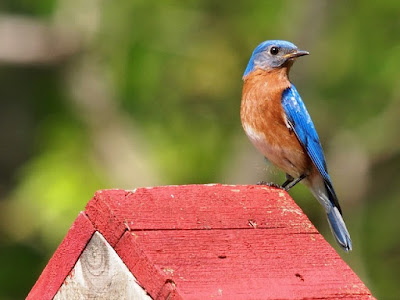 |
| Eastern Bluebird. skeeze Pixabay |
Range in Georgia: Eastern Bluebirds are year-round residents throughout Georgia.
Identification:
Size: Larger than House Finches. Much smaller than starlings. About length of White-crowned Sparrow but differently proportioned.
Shape: Chunky, large head, short tail. Bill: Straight, fairly slender, curved at tip.
Color: Males are brilliant blue above (including wings and tail), rusty orange below with white belly and under tail. Females are often much paler, almost grayish.
Habitat, range & behavior: Found in pasture, fields, golf courses, open woodland edges.
They are resident in most of eastern US, highlands of Middle America. In summer reach northernmost eastern US and southernmost eastern Canada, withdrawing somewhat in winter.
They readily use nest boxes, but the entrance hole must be smaller than the head of a starling, and without a perch.
Food and feeder preference: They eat flying insects primarily, but also other invertebrates and berries. They will eat mealworms at your feeder and frequent birdbaths.
13. House Finch (Haemorhous mexicanus)
Originally a bird of the West, now found in backyards across most of the US. There are other red finches, but these are the most common and most likely in residential areas.
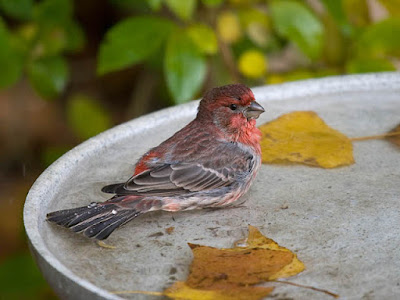 |
| House Finch. Greg Gillson |
Range in Georgia: House Finches are year-round residents throughout Georgia.
Identification: This is a key species for comparing with an unknown bird.
Size: About 6 inches from bill tip to tail tip. Larger than goldfinches and chickadees. Smaller than a White-crowned Sparrows or Spotted/Eastern towhees.
Shape: Medium build with a medium-long notched tail. Round head.
Bill: Short, conical. Color: Brown and gray above with streaks on the sides of the pale underparts. Males with red (sometimes orange or rarely yellow) crown, chest, rump.
Habitat, range & behavior: You’ll find small flocks on wires, in short treetops and in bushes. Originally deserts and grasslands. Rural areas and towns are where they’re now most common.
Formerly found in the western United States and Mexico. Then introduced into the northeastern United States, but now found in nearly all of the lower-48 states and extreme southern Canada. Rare in plains states (Dakotas to Texas) and southern Florida.
House Finches are not territorial, but males sing throughout the year–a lively, wiry song ending in a couple of buzzy notes.
Food and feeder preference: They love sunflower seeds and tube feeders. May eat from thistle socks.
You may like my in-depth article on attracting House Finches.
14. American Robin (Turdus migratorius)
This familiar backyard bird is a resident in the northern half of the United States and a common winter visitor in the southern half.
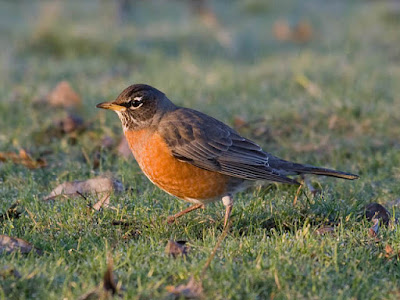 |
| American Robin. Greg Gillson |
Range in Georgia: American Robins are year-round residents throughout Georgia.
Identification: This is a key species for comparing with an unknown bird.
Size: 10 inches long from bill tip to tail tip. About the same size as a Blue Jay or one of the Scrub-Jays. Larger than Red-winged Blackbird. Smaller than a Mourning Dove.
Shape: Very plump with a fairly long tail.
Bill: Straight and fairly slender, curved at the tip.
Color: Gray-brown upperparts, rusty orange breast.
Habitat, range & behavior: Open woodlands, farmlands, urban parks and lawns.
Migratory, breed north across Alaska and Canada. Resident in most of the United States (lower 48). Winters in the United States, Mexico, to central America.
Hops on your lawn turning head this way and that looking for food. Their caroling song is one of the early signs of spring in the north.
Food and feeder preference: Diet is worms and other invertebrates in the lawn. May eat fruit from a tray feeder or the ground. Eat small berries from trees and bushes.
15. Eastern Phoebe (Sayornis phoebe)
Phoebes are an unusual group of flycatchers in that they can be common backyard birds.
 |
| Eastern Phoebe. Greg Gillson |
Range in Georgia: Eastern Phoebes are year-round residents throughout most of Georgia, but winter visitors only to southern and southeastern (coastal) Georgia.
Identification:
Size: Larger than a House Finch. About the same length as a White-crowned Sparrow but differently shaped.
Shape: Plump, large but flat-headed, medium tail.
Bill: Straight, wide, triangular, slightly hooked at tip.
Color: Dull olive-brown above, white below, yellow wash on vent.
Habitat, range & behavior: Found in open woodlands, farmlands, often near water.
Resident in SE US and eastern Mexico. In summer extends northward through all of eastern United States and central Canada.
Sits upright on low perch, flicking tail, watching for flying insects which they sally out and grab.
Food and feeder preference: Eats flying insects, adding some fruits and berries in winter. May drink from birdbath. May nest on man-made structures (porch light) or corner shelf.
16. American Goldfinch (Spinus tristis)
A common and beautiful tiny finch familiar to many in its bright yellow summer plumage. Colloquially called a “wild canary.”
 |
| American Goldfinch. Greg Gillson |
Range in Georgia: American Goldfinches are winter residents in southern and southeastern Georgia, year-round residents in northern Georgia.
Identification: This is a key species for comparing with an unknown bird.
Size: Very small at about 5 inches from bill tip to tail tip. Similar in size to a chickadee. Larger than hummingbirds. Smaller than juncos and House Finches.
Shape: Tiny, somewhat plump with larger head and short tail.
Bill: Short, conical, pink.
Color: Males in summer are bright lemon yellow with black forehead and black wings and tail with white bars. White under tail coverts. Females are dull olive, wings and tail browner. Winter birds are pale grayish-yellow with tan and brown wings and tail.
Habitat, range & behavior: This species is found in weedy fields and similar clearings with thistles and similar plants.
It is found coast-to-coast throughout the year across most of the middle lower-48 states. In summer moves north to the Canada border. In the winter found south to the Mexico border.
The flight is highly undulating, rising and falling as they flap in short bursts. Besides a long, sweet lilting song, they call in flight a lilting 4-part: “potato chip!”
Food and feeder preference: Feeds on weed seeds, thistle seed. May eat black oil sunflower seeds from tube feeder. Attract with Niger seed in a feeder called a “thistle sock.”
You may like my in-depth article on attracting American Goldfinches.
17. Brown-headed Nuthatch (Sitta pusilla)
These small birds are very social, traveling in noisy groups.
 |
| Brown-headed Nuthatch. mlmclaren Pixabay |
Range in Georgia: Brown-headed Nuthatches are year-round residents throughout Georgia.
Identification:
Size: Tiny; smaller than chickadees and goldfinches, though part of that is the very short tail.
Shape: Round body. Short tail. Large head on short neck.
Bill: Fairly long, slender, acute.
Color: Blue-gray back. Brown head. Dark wings. White under parts.
Habitat, range & behavior: Open mature pine forests.
Live in the SE United States.
Crawls up, down, and over bark and branches searching for food.
Food and feeder preference: Eat primarily spiders and bark-dwelling insects. In winter eat pine seeds. They will come to feeders for sunflower seeds and, especially, suet.
18. Chipping Sparrow (Spizella passerina)
Widespread species adapted to human disturbance. Rather tame, found in parks and cemeteries with larger trees.
 |
| Chipping Sparrow. Greg Gillson |
Range in Georgia: Chipping Sparrows are summer residents throughout interior Georgia, winter visitors only in coastal southeast Georgia.
Identification:
Size: A small sparrow, bigger than a goldfinch or chickadee, but smaller than a House Finch or Song Sparrow.
Shape: Plump and fairly long tailed.
Bill: Short and conical.
Color: Striped brown and dark brown above. Grayish under parts. Black line through eye. Crown streaked in winter but in summer becomes solid chestnut. Two white wing bars.
Habitat, range & behavior: Grassy open conifer woodlands with some shrubs, parks, orchards.
Breeds from Alaska, across Canada and south into highlands of Middle America. In winter retreats from northern areas to southern United States and northern Mexico.
In summer solitary or in pairs. In winter they forage in flocks of up to 50 birds.
Food and feeder preference: Diet is weed seeds, supplemented with insects in summer. They may eat black oil sunflower seeds in your feeder, but more likely will feed on mixed seeds on the ground under the feeder.
19. Brown Thrasher (Toxostoma rufum)
This excellent songster delivers its varied songs from a tall perch. Otherwise, it hides in dense tangles.
 |
| Brown Thrasher. Linda Jones Creative Commons (CC0) |
Range in Georgia: Brown Thrashers are year-round residents throughout Georgia.
Identification:
Size: The size of an American Robin or larger, approaching a Mourning Dove in length.
Shape: Long. Pot belly. Large head. Long ample tail. Long legs.
Bill: Slender, fairly long, slightly curved.
Color: Rusty above, with rusty streaks on creamy under parts. Yellow eye. Two white wing bars.
Habitat, range & behavior: Woodland, edges, dense thickets, farms.
Resident in the southeastern US. In summer breeds north to southern Canada.
Forages on ground. Flees to dense cover at first sign of danger.
Food and feeder preference: Half of its diet is insects and invertebrates. Also eats fruit and nuts, including acorns. Attract to your backyard with dense berry-producing shrubs. They may clean up spilled seeds on the ground under the feeder.
20. Pine Warbler (Setophaga pinus)
Eats seeds in winter, thus appears regularly at backyard feeders.
 |
| Pine Warbler. skeeze Pixabay |
Range in Georgia: Pine Warblers are year-round residents throughout Georgia.
Identification:
Size: A small bird about the size of an American Goldfinch or chickadee. A larger warbler, but still smaller than a House Finch.
Shape: Long tail and rather heavy bill.
Bill: Medium length, slender, straight, pointed. Heavier and more substantial than most other warbler bills.
Color: Olive above, yellow below. Wings gray with two white wing bars. Belly white. Split yellow eye ring on greenish face.
Habitat, range & behavior: Found in pine forests, often quite high in the tops of the trees.
Resident in the SE US and in summer to SE Canada.
Rather slow and sluggish compared to other warblers. Can form large flocks in winter.
Food and feeder preference: Diet is caterpillars and other insects, fruits and pine seeds. The best way to attract them to your feeder is with suet.
21. White-breasted Nuthatch (Sitta carolinensis)
A favorite backyard feeder bird for many for its active antics and fearlessness. Though a small bird it is the largest nuthatch in North America.
 |
| White-breasted Nuthatch. Greg Gillson |
Range in Georgia: White-breasted Nuthatches are year-round residents throughout Georgia.
Identification:
Size: About chickadee-sized in length. Smaller than a junco or House Finch.
Shape: Appears large-headed, neckless, very short tailed. Short legs.
Bill: Nearly as long as head, straight, thin.
Color: Blue-gray above, white below. Black cap, wing tips, tail. Rusty feathers under tail.
Habitat, range & behavior: Common in oak and oak-pine woodlands, wooded towns.
Found across the United States, southern Canada, mountains of central Mexico. Absent from treeless grasslands, deserts in the west.
Crawls over tree branches and head-first down tree trunks searching for insects.
Food and feeder preference: Diet is insects, seeds, acorns and other nuts. Attract with black oil sunflower seeds on hopper and tray feeders. Suet blocks.
22. Yellow-rumped Warbler (Setophaga coronata)
An abundant winter visitor in southern US to treetops and weedy areas.
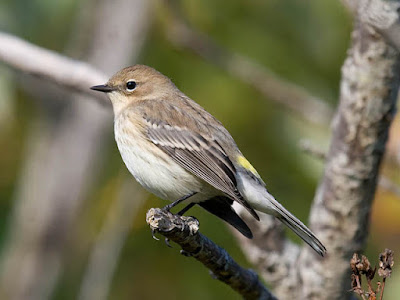 |
| Yellow-rumped Warbler. Greg Gillson |
Range in Georgia: Yellow-rumped Warblers are winter visitors throughout Georgia.
Identification:
Size: Small, they are a bit larger than chickadees and goldfinches. They are smaller than House Finches and juncos.
Shape: Plump and neckless with a shorter tail.
Bill: Short, slender, straight, pointed.
Color: Breeding plumage in spring is blue-gray on the upper parts, black sides and chest, yellow rump, yellow on sides. Two forms: western form with yellow throat and large white wing patch; eastern and northern form with white throat and two white wing bars. In winter plumage both forms are gray-brown above, pale cream below. Yellow rump and white tail corners in flight.
Habitat, range & behavior: In breeding season mostly in coniferous or mixed forests, in mountains in west. In winter open areas with fruiting shrubs and scattered trees.
Breed across Canada and Alaska and in conifer forests in the west. Winter along both coasts and the southern states through Middle America. There are also non-migratory forms in Mexico and Guatemala.
They tend to forage in outer branches about half way up the tree.
Food and feeder preference: Their diet is mainly insects in the summer, they switch to waxy berries and fruit in winter. They are thus able to winter farther north than other warblers. They are attracted to suet feeders.
23. Song Sparrow (Melospiza melodia)
A common bird, but variable, and similar to many other streaked brown sparrows.
 |
| Song Sparrow. Greg Gillson. |
Range in Georgia: Song Sparrows are winter visitors only throughout most of Georgia, year-round residents in northern Georgia.
Identification:
Size: A smaller bird, similar in size to House Finch and juncos. Larger than chickadees and goldfinches. Smaller than White-crowned Sparrows or Spotted/Eastern towhees.
Shape: Plump with round head, long rounded tail.
Bill: Short, conical.
Color: Highly variable in darkness and color saturation across its range (dark rusty to pale gray). Generally gray-brown above with dark brown streaking on back. Complicated head pattern. Streaking on sides and breast converge into dense central breast spot.
Habitat, range & behavior: Thickets, especially near water. Backyard shrubbery.
Resident in western United States, western Canada, coastal southern Alaska, northeastern US. In summer also moves into mid-Canada and northern half of US. In the winter found in most of the US lower-48. Also, a population in central Mexico.
Forages on ground, never far from low cover to which they fly if startled.
Food and feeder preference: Song Sparrows feed on seeds and insects near the ground. Will visit hopper and tray feeders for mixed bird seed.
24. Red-winged Blackbird (Agelaius phoeniceus)
These noisy flocking birds are most often found in marshes. But in winter they are found in backyards.
 |
| Male Red-winged Blackbird. Greg Gillson. |
 |
| Female Red-winged Blackbird. Greg Gillson. |
Range in Georgia: Red-winged Blackbirds are year-round residents throughout Georgia.
Identification: This is a key species for comparing with an unknown bird.
Size: About 8-3/4 inches long from bill tip to tail tip. About the size of a Northern Cardinal. Smaller than an American Robin.
Shape: Pot-bellied with a longer bill and flat forehead. Tail average.
Bill: Long and sharp pointed.
Color: Males are black with red and yellow shoulder patch. Females are streaked brown and rusty (sparrow-like but pointed bill and flat forehead).
Habitat, range, and behavior: Cattail marshes and wetlands are their summer habitat. In winter they feed in grain fields.
They breed across most of the North American continent. In winter they withdraw from most of Alaska and Canada.
They are found in colonies in summer and large flocks in winter.
Food and feeder preference: They eat insects in summer. In winter they eat grain and seeds. They visit feeders, more often in large winter flocks, and eat most seeds and suet.
25. Ruby-crowned Kinglet (Regulus calendula)
These tiny little hyperactive balls of feathers are very similar in appearance to sluggish Hutton’s Vireos. Note the yellow feet and skinny black legs of the kinglet.
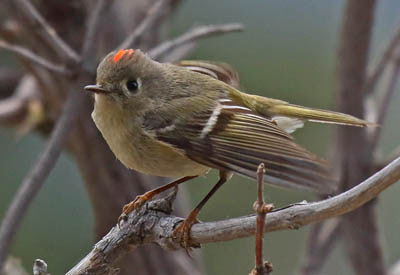 |
| Ruby-crowned Kinglet. Greg Gillson. |
Range in Georgia: Ruby-crowned Kinglets are winter visitors throughout Georgia.
Identification:
Size: Smaller than a chickadee or goldfinch.
Shape: Plump, almost round body with round head merging into the body almost without neck. Very short tail. Thin legs.
Bill: Very short, rather thin.
Color: Olive-green, tending toward gray, especially on the head. Paler yellow-green below. Wing gray with yellow-green edges to the wing feathers. Two white wing bars with distinctive black panel below the lower wing panel. White eye ring slightly broken on top and bottom. Red crown of male only shows when agitated. Legs very thin, black, with obvious yellow soles to the feet.
Habitat, range, and behavior: Mountain conifers in summer, brushy patches and chaparral in winter. Residential landscaping hedges and bushes.
Breeds in Alaska, across Canada, and mountains of the West. Migrates through all of US. Winters in coastal East, Southeast, West, into Mexico.
Active flitting from branch to branch, in interior of bushes and small trees, in short flap-hops. Constantly twitches wings. Hover-gleans at leaf tips.
Food and feeder preference: Ruby-crowned Kinglets feed in bushes next to house looking for spiders and insects. May eat at suet feeder.
26. White-throated Sparrow (Zonotrichia albicollis)
A fairly common bird of northern forests that visits backyards across much of the US.
 |
| White-throated Sparrow. Greg Gillson |
Range in Georgia: White-throated Sparrows are winter visitors throughout Georgia.
Identification:
Size: Similar in size to White-crowned Sparrow. Bigger than a House Finch; smaller than a starling.
Shape: Longer body. Round head on short neck. Long tail with notched tip.
Bill: Short. conical.
Color: Striped tan and brown above, pale gray below. White-striped form with black and white head stripes. Tan-striped form with tan and brown striped head. First year birds are similar to tan-stiped adults, but streakier overall. Yellow spot between eyebrow and bill. White throat strongly offset from gray breast and face.
Habitat, range & behavior: Found in forests, brush, and open woodland edges.
Breeds across Canada and northernmost Eastern United States. Winters in the eastern US, southern central US, and rare but regular along the West Coast.
Found in small flocks on ground near brush into which they can flee. Kick up leaves to search under for food.
Food and feeder preference: Eat seeds and berries in winter, more insects and fruit in summer. In your feeder will eat mixed seeds on a platform feeder and on the ground.
27. Ruby-throated Hummingbird (Archilochus colubris)
This is the only hummingbird that breeds in the eastern half of the United States and Canada.
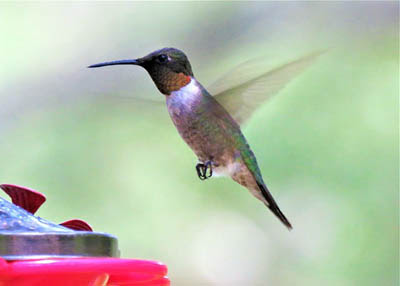 |
| Ruby-throated Hummingbird. GeorgeB2 from Pixabay. |
Range in Georgia: Ruby-throated Hummingbirds are summer residents throughout Georgia.
Identification:
Size: A tiny bird, much smaller than any other in the eastern US, except perhaps some other rare hummingbird.
Shape: The small body is chunky, with a big head, and short tail.
Bill: Very long and tubular, slightly down curved.
Color: Metallic green above, white below with scattered green or gray feathers. Male with glimmering ruby red throat that is black unless it refracts sunlight at just the right angle.
Habitat, range & behavior: They find flowers at forest edges and flower gardens.
They summer in the eastern US and southern Canada, east of the Rocky Mountains. Some winter in from the coast of the Carolinas to Florida and along the Gulf Coast.
Darting flight on a blur of wings that buzz when they flap so fast! They feed by poking their long bill into flowers.
Food and feeder preference: They drink flower nectar from tubular flowers using their long brush-tipped tongue. They also feed on spiders and small flying insects. They are readily attracted to hummingbird feeders filled with sugar water.
Common Birds in Georgia
To determine how common each species is I used the data from actual bird sightings from the citizen science program eBird. Birds are listed by frequency. That is, how often the species is recorded on checklists submitted to eBird (a percentage).
When choosing the birds to include in this article I leaned strongly to birds that are present throughout the year in good numbers. Thus, many of the common birds are year-round residents. This means that they live in the same location all year. They raise their young in your neighborhood. They don’t migrate. Or if the species does migrate, the ones living in your area don’t. If this is the case, some migrants may move into your area during certain times of year, adding to the same species that are in your yard full time.
Some migrant birds visit your yard during the “summer.” Often, they arrive in spring and remain until late fall. They nest and raise their young in your neighborhood. These are the summer residents.
Other migrant birds visit your backyard during the “winter.” Some of these winter visitors may arrive in July and remain into April. Others may only be found in the cold of December or January. They key here is that they nest and raise their young somewhere else. They only visit your yard in the non-breeding season.
Migration is an amazing spectacle.
There will be birds that fly through your region in spring or fall (or both). They may visit your backyard only a few days or weeks a year. They aren’t regular enough, or stay long enough, to be included in this article. But the number of briefly visiting migrant birds could double the number of species presented here. You may see them over time. Consult checklists in eBird for your county to see what is possible.
I have generally excluded common waterfowl, birds of prey, shorebirds, seabirds, and others that aren’t usually found in residential areas. But they may certainly fly over or be seen regularly if your home is on a shoreline, for instance.
Most common backyard birds in Georgia throughout the year
The following list is the backyard birds that are, on average, most common throughout the entire year. The list is ordered by most common based on the frequency of how often each species is recorded on checklists submitted to eBird.
- Northern Cardinal (64% frequency)
- Carolina Wren (52%)
- Carolina Chickadee (48%)
- Tufted Titmouse (47%)
- Mourning Dove (43%)
- Red-bellied Woodpecker (42%)
- Blue Jay (42%)
- American Crow (38%)
- Northern Mockingbird (37%)
- Eastern Towhee (34%)
- Downy Woodpecker (34%)
- Eastern Bluebird (32%)
- House Finch (29%)
- American Robin (29%)
- Eastern Phoebe (27%)
- American Goldfinch (25%)
- Brown-headed Nuthatch (23%)
- Chipping Sparrow (23%)
- Brown Thrasher (23%)
- Pine Warbler (23%)
- White-breasted Nuthatch (23%)
- Yellow-rumped Warbler (20%)
- Song Sparrow (19%)
- Red-winged Blackbird (17%)
- Ruby-crowned Kinglet (15%)
Most common backyard birds in Georgia in winter
- Northern Cardinal (58% frequency)
- Carolina Chickadee (49%)
- Carolina Wren (48%)
- Tufted Titmouse (45%)
- Red-bellied Woodpecker (40%)
- Mourning Dove (39%)
- American Crow (36%)
- Downy Woodpecker (34%)
- Blue Jay (34%)
- Eastern Bluebird (33%)
- Northern Mockingbird (32%)
- American Robin (31%)
- Yellow-rumped Warbler (31%)
- House Finch (29%)
- Eastern Towhee (29%)
- American Goldfinch (28%)
- Pine Warbler (27%)
- Eastern Phoebe (26%)
- Ruby-crowned Kinglet (26%)
- Chipping Sparrow (25%)
- Song Sparrow (25%)
- Brown-headed Nuthatch (24%)
- White-breasted Nuthatch (24%)
- White-throated Sparrow (21%)
Most common backyard birds in Georgia in summer
- Northern Cardinal (66% frequency)
- Carolina Wren (52%)
- Mourning Dove (50%)
- Tufted Titmouse (42%)
- Blue Jay (41%)
- Northern Mockingbird (40%)
- Eastern Towhee (40%)
- Carolina Chickadee (39%)
- American Crow (36%)
- Red-bellied Woodpecker (36%)
- Eastern Bluebird (30%)
- House Finch (30%)
- Downy Woodpecker (27%)
- American Robin (26%)
- Brown Thrasher (25%)
- Ruby-throated Hummingbird (23%)
- American Goldfinch (22%)
- Chipping Sparrow (22%)
Common Backyard Birds of Atlanta, Georgia
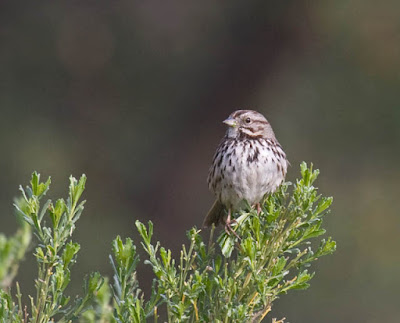 |
| Song Sparrow is a common backyard bird in Atlanta Photo by Greg Gillson |
- Northern Cardinal (73% frequency)
- Carolina Chickadee (54%)
- Carolina Wren (53%)
- Tufted Titmouse (50%)
- Eastern Towhee (48%)
- Blue Jay (47%)
- American Robin (47%)
- Downy Woodpecker (44%)
- Mourning Dove (43%)
- Red-bellied Woodpecker (42%)
- House Finch (42%)
- White-breasted Nuthatch (41%)
- Northern Mockingbird (38%)
- Song Sparrow (35%)
- American Goldfinch (33%)
- Brown-headed Nuthatch (32%)
- Brown Thrasher (32%)
- Eastern Bluebird (32%)
- American Crow (30%)
- Eastern Phoebe (28%)
- Yellow-rumped Warbler (23%)
- White-throated Sparrow (22%)
- Chipping Sparrow (22%)
- Pine Warbler (21%)
- Ruby-crowned Kinglet (20%)
The common backyard birds in the Atlanta area are quite similar to the birds of the state of Georgia as a whole.
Wow, there are a lot of cardinals! They appear on 3 of every four checklists.
Song Sparrows are more frequent in the Atlanta area.
Common Backyard Birds of Savannah, Georgia
- Northern Cardinal (56% frequency)
- Carolina Wren (47%)
- Northern Mockingbird (43%)
- Mourning Dove (39%)
- Carolina Chickadee (39%)
- Red-bellied Woodpecker (38%)
- Yellow-rumped Warbler (33%)
- Tufted Titmouse (31%)
- House Finch (30%)
- Blue Jay (30%)
- American Crow (29%)
- Downy Woodpecker (28%)
- Boat-tailed Grackle (26%) Learn about this species on eBird
- Eastern Bluebird (24%)
- Red-winged Blackbird (20%)
- Pine Warbler (19%)
- Brown-headed Nuthatch (17%)
Tufted Titmice, Carolina Chickadees, and Eastern Towhees are a bit less common in Savannah than in the state as a whole.
Boat-tailed Grackles are common in Savannah and coastal Georgia, absent in most of Georgia.
Wrapping Up
So there are the common backyard birds of Georgia and I am pleased to see there are woodpeckers frequenting the lists. Visit any woodland in Georgia and you are likely to hear at least one of the 3 resident peckers.
Red-bellied Woodpecker: The most common woodpecker in Georgia, with a red patch on its nape and a loud drumming sound.
Downy Woodpecker: A small, black and white woodpecker often seen clinging to tree trunks.
Hairy Woodpecker: Similar to the Downy Woodpecker but slightly larger with a longer bill.
Frequently Asked Questions
What is the state bird of Georgia?
The state bird of Georgia is the brown thrasher! It’s a beautiful, long-tailed bird with a rufous brown back and streaked chest and belly. They’re known for their amazing singing abilities, mimicking the sounds of other birds and even insects.
What is the screeching bird in Georgia?
Eastern Screech Owls are common throughout Georgia, USA, but pinpointing their exact location requires some detective work without visual aids. Here are some tips to help you increase your chances of encountering one:
Habitat:
- Wooded areas: Screech owls favor wooded habitats like forests, parks, and even backyards with mature trees. They often nest in cavities or abandoned woodpecker holes.
- Edge habitats: Look for areas where woodlands meet open fields or meadows, as these provide prime hunting grounds for the owls.
- Water sources: Screech owls frequently visit ponds, streams, and creeks for a drink, especially during dry periods.
Timing:
- Nighttime: Screech owls are nocturnal creatures, so your best chance of seeing or hearing one is after sunset. They are most active from dusk until around midnight.
- Listen for their calls: Screech owls have a distinctive, high-pitched “screech” call, which they repeat at regular intervals. They also have a softer, trilling call used for communication.
- Be still and observant: Once you’re in a suitable habitat at night, stay quiet and still. Scan the tree branches and listen carefully for any owl calls or movements.
Additional tips:
- Look for signs: Owl pellets, which are balls of indigestible prey remains, can indicate the presence of a screech owl nearby.
- Join a nature walk: Some parks and nature centers organize owl-watching activities led by experienced guides who can help you spot these elusive birds.
- Respect the owls: If you do encounter a screech owl, avoid disturbing it. Maintain a safe distance and observe quietly. Remember, they are wild animals and deserve our respect.
Related Articles:
Red, Orange, & Yellow birds of Georgia
Feeding winter birds in Georgia
How to identify birds: 7 Steps to accurately identify birds
Please also check out my recommended products page. There I maintain a list of the best feeders, bird foods, binoculars, bird baths, fountains, books and other bird watching items.






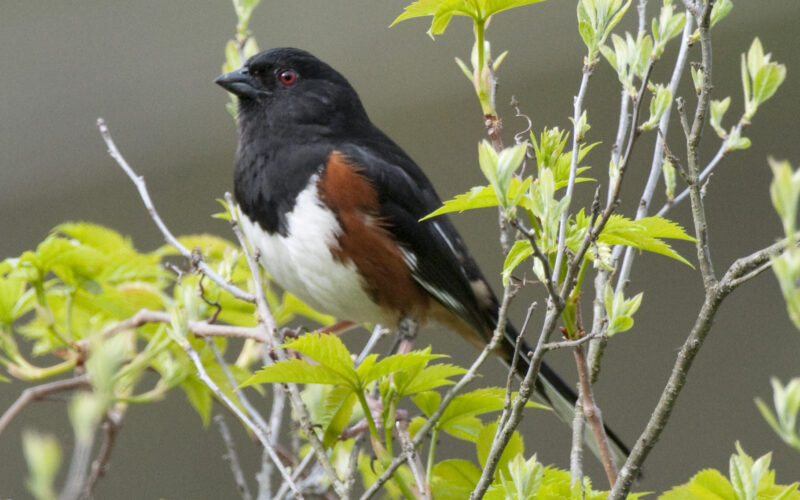




This is such a great wealth of information on the feathered friends I've been wondering about. I sat down on my porch while reading it and was finally able to figure out what the little white and black headed fellows who've been visiting me are (Carolina Chickadee). Thanks so much for the photos and awesomely put together info!
Julie,
That is so wonderful to hear! Thank you. I wrote it to be the best answer to figuring out your backyard birds. I'm so glad that it worked for you!
Thank you real help with birds thank you!
You are welcome!
My little pink bird is a house finch! Thank you!
Congratulations on your bird identification success!
You’re so right I have those same little ones visiting my feeder as well but I came across a new one last week and she seems to be staying around and she is a pine warbler. It’s nice to know that I’m not the only one who sees beauty in the birds.
Wonderful! I haven't seen a Pine Warbler yet.